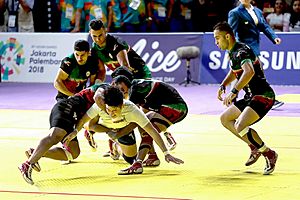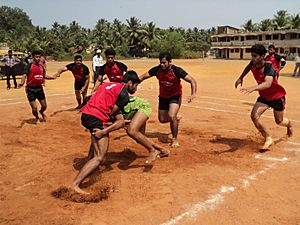Kabaddi facts for kids

A kabaddi match during the 2018 Asian Games.
|
|
| Highest governing body | International Kabaddi Federation |
|---|---|
| Nicknames | Kaudi, Pakaada, Hadudu, Bhavatik, Saadukuda, Hu-Tu-Tu, Himoshika, sadugudu |
| Characteristics | |
| Contact | Permitted |
| Team members | 7 (per side) |
| Mixed-sex | Yes, separate competitions |
| Type | Team sport, Contact sport |
| Equipment | None |
| Venue | Kabaddi court |
| Presence | |
| Country or region | Indian Subcontinent, Asia |
| Olympic | Demonstration sport: 1936 Olympics |
Kabaddi is an exciting contact team sport. Two teams of seven players compete against each other. The main goal is for one player, called a "raider," to run into the other team's side of the court. The raider tries to tag as many opponents as possible. They must do this and return to their own side without being tackled. All of this has to happen in a single breath!
Players score points for each opponent the raider tags. The other team gets a point if they stop the raider. If a player is tagged or tackled, they are out of the game. But don't worry, players can come back! They are "revived" for every point their team scores.
In international kabaddi, teams have seven players on the field. Each team also has three extra players in reserve. The playing field is 10 meters by 13 meters for men. For women, it is 8 meters by 12 meters. A game has two 20-minute halves. There is a five-minute break at half-time. During the break, the teams switch sides. Matches are set up based on age and weight. Six officials watch over the game. These include a referee, two umpires, and three scorers.
Kabaddi is very popular in the Indian subcontinent and other nearby countries. These include Iran and Pakistan. Stories about kabaddi go back a long time in India and Iran. But the sport became popular for competitions in the 1900s, thanks to India. It is the state game in many Indian states. It is also the national sport of Bangladesh.
There are two main ways to play kabaddi. "Circle style" kabaddi is a traditional game played outdoors on a round field. It is also known as Punjabi kabaddi. The "standard style" is played indoors on a rectangular court. This is the style used in big professional leagues and tournaments. Kabaddi was shown at the 1982 Asian Games. It then became a regular sport at the Asian Games starting in 1990.
The word "kabaddi" comes from the Tamil words "kai-pidi." This means "to hold hands."
Kabaddi's Popularity
Kabaddi is a very popular sport in India and across Asia. The Kabaddi Federation of India (KFI) was started in 1950. This group created the official rules for the game. In Pakistan, the Pakistan Kabaddi Federation manages the sport. Kabaddi is the national game of Bangladesh. The Amateur Kabaddi Federation of Bangladesh was formed in 1973.
In Iran, the Community of Kabaddi was created in 1996. They joined the Asian Kabaddi Federation in the same year. In 2001, they joined the International Kabaddi Federation. The Iran Amateur Kabaddi Federation was formed in 2004.
Kabaddi is also one of the national sports of Nepal. Many primary schools in Nepal teach kabaddi to young students, often starting around third grade. The British Army also played kabaddi for fun. It helped soldiers stay fit and encouraged people from British Asian communities to join the army. Kabaddi came to the United Kingdom with Indian and Pakistani immigrants. The England Kabaddi Federation UK is the main group for kabaddi in the United Kingdom.
Images for kids
-
A circle kabaddi match being played in Bhimber.
See also
 In Spanish: Kabaddi para niños
In Spanish: Kabaddi para niños





